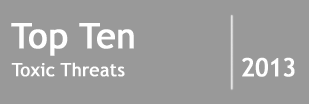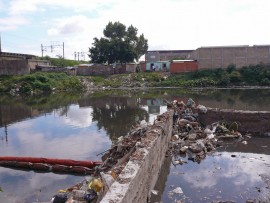Matanza-Riachuelo, Argentina
Pollutant: Volatile organic compounds, including toluene
Population Affected: 20,000+
The Matanza-Riachuelo River Basin is more than 60 kilometers long and houses a number of SME clusters, including chemical manufacturers. It is estimated that 15,000 industries are actively releasing effluent into the river, which cuts through 14 municipalities in Buenos Aires.[1] Chemical manufacturers are responsible for more than a third of the pollution.
Pollutants in the Matanza River vary greatly. A study published in the Latin American Journal of Sedimentology and Basin Analysis in 2008 revealed that soil on the banks of the river contained levels of zinc, lead, copper, nickel, and total chromium that were all above recommended levels. Chromium, for example, had a mean value in soil of 1,141 ppm, which is significantly higher than the recommended level of 220 ppm.[2]
It’s believed that 60% of the approximately 20,000 people who reside near the river basin live in territory deemed unsuitable for human habitation, with 6% living in the basin’s most unsuitable conditions.[3] Environmental factors such as diarrheal diseases, respiratory diseases, and cancer are significant public health problems associated with the multiple industries in the basin. A 2013 article published in Salud Colectiva found that 80% of water samples taken from wells near the Matanza-Riachuelo river basin were not safe for drinking due to contamination.[4] This issue is aggravated by inadequate infrastructure in the nearby informal settlements, where residents are left with few options for drinking water.[5]
Several important programs are making progress on the issue. Most significantly a billion dollar World Bank funded effort will focus on sanitation and industrial pollutant abatement.[6] Given the scale of the investment and the actors involved, considerable progress is anticipated.
[2] 1 Ronco, Alicia et al. "Screening of Sediment Pollution in Tributaries from the Southwestern Coast of the Río De La Plata Estuary." Latin American Journal of Sedimentology and Basin Analysis (2008).
[3] Pietri, DD, P. Dietrich, P. Mayo, and A. Carcagno. "[Multicriteria Evaluation of Environmental Risk Exposure Using a Geographic Information System in Argentina]." Revista Panamericana De Salud Publica 30.4 (2011): 377-78.
[4] Quality of Water for Human Consumption: The Health of the Population Residing in the Matanza-Riachuelo River Basin Area in Greater Buenos Aires]." Salud Colectiva 9.1 (2013): 53-63.
[5] IRC International Water and Sanitation Centre, 2009. Available at: http://www.source.irc.nl/page/46738
[6]World Bank, 2013. Available at: http://www.worldbank.org/projects/P105680/matanza-riachuelo-basin-mrb-sustainable-development-adaptable-lending-program?lang=en&tab=overview




